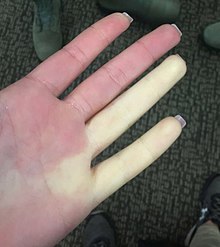| Raynaud syndrome | |
|---|---|
| Other names | Raynaud's, Raynaud's disease, Raynaud's phenomenon, Raynaud's syndrome[1] |
 | |
| A hand with pale fingers due to Raynaud's | |
| Pronunciation | |
| Specialty | Rheumatology |
| Symptoms | An affected part turning white, then blue, then red, burning[2] |
| Complications | skin sores, gangrene[2] |
| Usual onset | 15–30 year old, typically females[3][4] |
| Duration | Up to several hours per episode[2] |
| Risk factors | Cold, emotional stress[2] |
| Diagnostic method | Based on the symptoms[3] |
| Differential diagnosis | Causalgia, erythromelalgia[5] |
| Treatment | Avoiding cold, calcium channel blockers, iloprost[3] |
| Frequency | 4% of people[3] |
Raynaud syndrome, also known as Raynaud's phenomenon, is a medical condition in which spasm of arteries cause episodes of reduced blood flow.[1] Typically, the fingers, and less commonly the toes, are involved.[1] Rarely, the nose, ears, or lips are affected.[1] The episodes result in the affected part turning white and then blue.[2] Often, numbness or pain occurs.[2] As blood flow returns, the area turns red and burns.[2] The episodes typically last minutes, but can last several hours.[2]
Episodes are often triggered by cold or emotional stress.[2] The two main types are primary Raynaud's, when the cause is unknown, and secondary Raynaud's, which occurs as a result of another condition.[3] Secondary Raynaud's can occur due to a connective-tissue disorder, such as scleroderma or lupus, injuries to the hands, prolonged vibration, smoking, thyroid problems, and certain medications, such as birth control pills.[6] Diagnosis is typically based on the symptoms.[3]
The primary treatment is avoiding the cold.[3] Other measures include the discontinuation of nicotine or stimulant use.[3] Medications for treatment of cases that do not improve include calcium channel blockers and iloprost.[3] Little evidence supports alternative medicine.[3] Severe disease may rarely be complicated by skin sores or gangrene.[2]
About 4% of people have the condition.[3] Onset of the primary form is typically between ages 15 and 30 and occurs more frequently in females.[3][4] The secondary form usually affects older people.[4] Both forms are more common in cold climates.[4] It is named after the French physician Maurice Raynaud, who described the condition in 1862.[3]
References edit
- ^ a b c d "What Is Raynaud's?". NHLBI. 21 March 2014. Archived from the original on 4 October 2016. Retrieved 1 October 2016.
- ^ a b c d e f g h i j "What Are the Signs and Symptoms of Raynaud's?". NHLBI. 21 March 2014. Archived from the original on 5 October 2016. Retrieved 1 October 2016.
- ^ a b c d e f g h i j k l m Wigley, FM; Flavahan, NA (11 August 2016). "Raynaud's Phenomenon". The New England Journal of Medicine. 375 (6): 556–65. doi:10.1056/nejmra1507638. PMID 27509103.
- ^ a b c d "Who Is at Risk for Raynaud's?". NHLBI. 21 March 2014. Archived from the original on 5 October 2016. Retrieved 1 October 2016.
- ^ Barker, Roger A. (2005). The A-Z of Neurological Practice: A Guide to Clinical Neurology. Cambridge University Press. p. 728. ISBN 9780521629607. Archived from the original on 24 April 2017.
- ^ "What Causes Raynaud's?". NHLBI. 21 March 2014. Archived from the original on 4 October 2016. Retrieved 1 October 2016.